This is an entry in my Vermont 251 Club series. The main post — which lists all 252 places in Vermont — is here. As I visit each one and write about it, the name will become a live link. Middlebury and Montpelier are both available for free, but most of the series will be paywalled, so if you think you would enjoy reading more of these, consider subscribing. Here’s a coupon.
Edited after sending the emails out to add: if you haven’t already voted in my poll, I’d really appreciate it if you would. Thank you.
I spent a couple of days this week with
doing awesomely fun things. We locked our phones in the car for most of it — totally old-school, right down to the “If we get separated, let’s meet at the…” contingency plan.If you haven’t done that lately — gone several uninterrupted hours without a phone on your person, in the company of someone who really matters to you — I can’t recommend it enough. If Josh and I are even remotely typical American adults in this regard (and I think we are), the experience will be both startling and clarifying.
You might find yourself paying attention in a way you haven’t for years. You’ll notice things. You'll remember them.
The one part of our tech-free, soul-nourishing mini-adventure that I am going to share with the internet is our visit to Windsor, Vermont.
There, we stumbled across something jaw-droppingly perfect for both of us — and surprisingly delightful in ways we didn’t see coming.
Windsor is the birthplace of Vermont. It’s where the state constitution was drafted and adopted, and the town still has the stately pride to show for it. Constitution Hall sits on the same block as a row of jaw-dropping Federal and Greek Revival houses — 200-year-old showstoppers that look like they could collapse from the sheer weight of their dignity.
We couldn’t go inside Constitution Hall because it’s currently closed for refurbishment.
That turned out to be a blessing in disguise, because it gave us more time at the real star of the day: the American Precision Museum.
Housed in the original Robbins & Lawrence Armory, an 1846 brick factory that looks like it was built to survive both time and cannon fire, the APM is dedicated to preserving the history of precision manufacturing in America.
But that doesn’t quite capture it. This place doesn’t just house old machines; it tells the story of how American industry was shaped — literally — by inventiveness, grit, and the pursuit of parts that fit so precisely you could swap one for another without missing a beat.
The building's design, with its narrow width and abundant windows, was intentional to maximize natural light for workers—a testament to the thoughtful engineering of the era.
Before “Made in America” was a sticker, it was a revolution.
And it started here.
Anyone familiar with Josh’s writing or podcast knows he has a well-earned obsession with American craftsmanship — particularly the kind we’ve thrown away in favor of cheap, fragile junk. He buys 40-year-old appliances because they still work. They’re built to be repaired, not replaced.
And he’s right: our grandparents owned toasters that lasted longer than most modern marriages.
He’s also written about our dangerous overreliance on fragile, overcomplicated electronics — a topic I’ve covered too. We’ve both made the case, in our own ways, that planned obsolescence is not just annoying, but culturally corrosive.
It teaches us to expect failure, to discard rather than repair, to think of everything — objects, people, systems — as temporary.
And not in the good way, the way of appreciating the ubiquity of change. In the tragic and wasteful sense — the inability to count on things lasting that really should be counted upon. Things we know how to build to last, but we just…don’t…anymore.
So the APM wasn’t just an ideal spot for Josh; it was practically a spiritual pilgrimage.
And for me, an artist always on the lookout for unusual reference material and beautiful mechanical forms to draw, it was heaven. The museum is packed with machines that don’t just do things — they are things. Strange, gleaming, riveted, belt-driven beasts of beauty.
Almost everything in there begged to be drawn.
A Factory of Stone, Water, and Light
You don’t stumble into the American Precision Museum. You approach it — pulled, a little magnetically, by the sound of rushing water and the faint promise of something solid, old, and purposeful behind all the green.
The building itself is a marvel: four stories of weathered brick rising from a foundation of thick, carefully stacked stone.
It doesn’t try to charm you. It doesn’t need to. It stands with the kind of quiet, muscular confidence that says: I was built to do something, and I can do it very, very well.
And it was, and it did. Still does, in a new way.
In 1846, this building was a working armory — a place where machines were powered not by electricity, but by waterwheels and belts.
The line shafts are long gone, but the bones remain: stout, square windows that flood the factory floors with light.
Sturdy timber beams still doing their job a century and a half later.
We arrived under a cobalt blue, perfect Vermont sky, the kind of summer blue that makes the trees look greener and the flowers seem to glow from within. A perfect 65 degree day that felt like a proper New England summer day, not the who-transplanted-Mississippi-weather-all-the-way-up-here saunas we’d been enduring lately.
In front of the museum and to the side, tucked just out of street view, is a wild little Eden: orange daylilies and blood-red blooms curling through stone borders and rusted metal railings. An old mill race gurgles below, feeding the water that once drove the machines inside.
It’s the kind of place you don’t expect to find unless you know exactly what you’re looking for — and even then, it still feels like a secret.
Just a few steps from the front entrance, the river bends into a sudden cascade, the falls tumbling over dark rocks into a wide, flat basin. It’s not dramatic, exactly. It’s better. It’s working-water beautiful; the kind of natural feature early engineers looked at and said: Yes. This will do.
This will run.
From the garden paths to the rusted wheels embedded in granite outcroppings, every inch of the place breathes function and age.
And somehow, it still feels alive.
Not as a relic, but as a testament.
This was not a museum made for tourists. It was a building made for work — and now it tells the story of that work in the most intimate way imaginable: by letting you walk through it.
By letting you see what time, water, and iron can do.
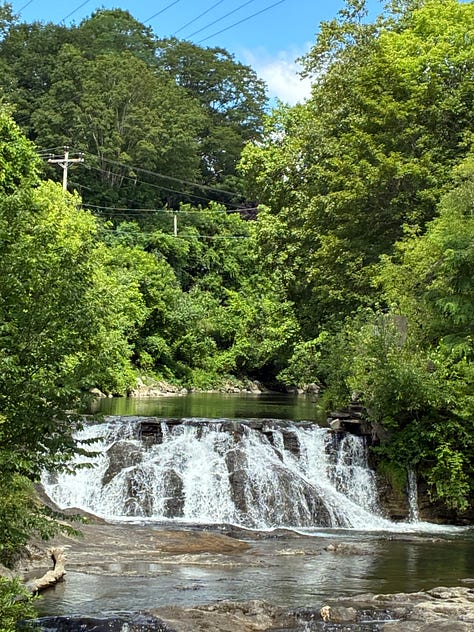
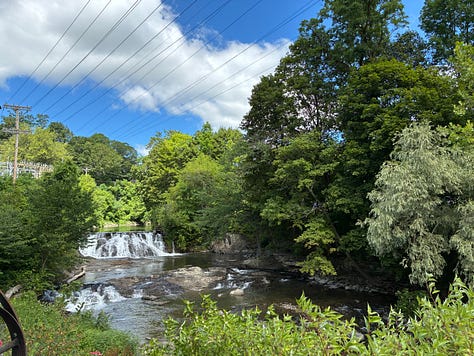


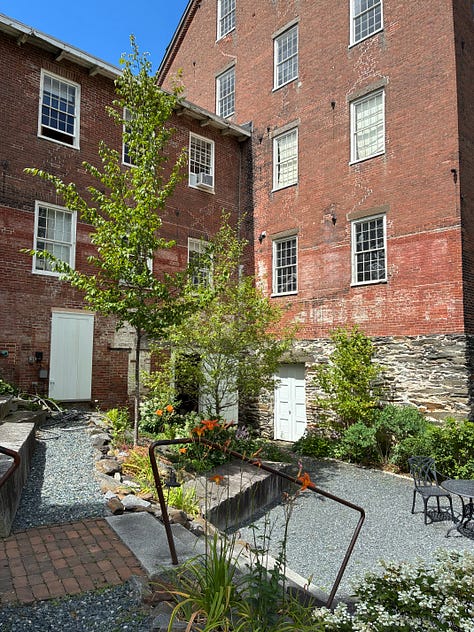
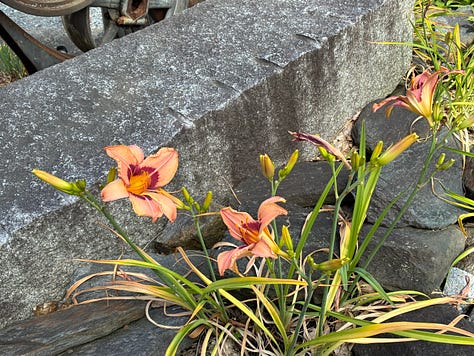
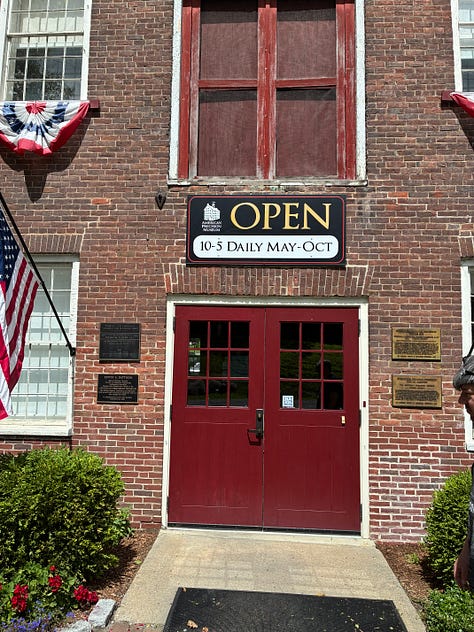

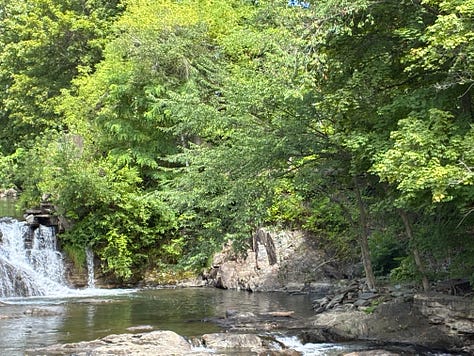
The Guns That Built the Machines That Built America
Inside, the museum does something quietly radical: it tells the truth about how the gun industry shaped American manufacturing — not just in purpose, but in precision.
What we saw wasn’t a collection of weapons, but the machinery behind them. The innovations that started in places like Windsor — innovations that would eventually become cornerstones of American industry: the division of labor, jig-based mechanization, and, most famously, interchangeable parts.
That last one stopped me in my tracks.
Interchangeable parts — the thing that makes modern repair possible, from tractors to toothbrushes, at least in the places where it is still possible.
A wartime necessity that became an industrial principle, one we abandoned at our peril and to our detriment.
Something that saved lives on battlefields and then built dishwashers in Peoria.
That shift — from musket to mass production — started here.
And somehow I didn’t know that.
Why not?
More pictures and details behind the paywall. Coupon here.
Keep reading with a 7-day free trial
Subscribe to Holly’s Substack to keep reading this post and get 7 days of free access to the full post archives.







